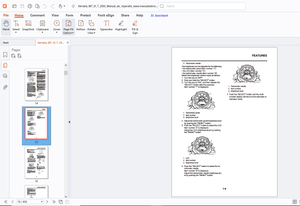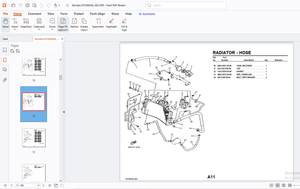$27
Deka Industrial Battery Service Manual – PDF DOWNLOAD
Deka Industrial Battery Service Manual – PDF DOWNLOAD
FILE DETAILS:
Deka Industrial Battery Service Manual – PDF DOWNLOAD
Language : English
Pages :44
Downloadable : Yes
File Type : PDF
TABLE OF CONTENTS:
Deka Industrial Battery Service Manual – PDF DOWNLOAD
INTRODUCTION 2
SECTION I – THEORY OF
OPERATION/BATTERY CONSTRUCTION 4
Discharging/Recharging Characteristics 4
Battery Ratings 4
Battery Voltage 4
Ampere Hour (AH) 5
Kilowatt Hours (KWH) 5
Positive Plate Capacity 5
Specific Gravity 5
Specific Gravity During Recharge 5
Grid Casting 6
Apply Active Material 6
Curing and Drying 6
Plate Formation 6
Wrapping Positive Plates 6
Assembling An Element 7
Finishing the Cell Assembly 7
Assembling into Trays 8
Battery Finishing and Shipping 8
SECTION II – BATTERY SAFETY 9
Hazardous Elements 9
Wearing Protective Clothing 9
Lifting Batteries 9
Using the Battery as a Counterbalance 9
CHARGING BATTERIES
Charging Areas – Proper Equipment 10
Charging Areas – Proper Ventilation 1 O
Connecting/Disconnecting Charger 1 O
Sparks/Open Flames 1 O
HANDLING ACID
Pouring Acid 1 O
Mixing Electrolyte 1 O
First Aid for Acid Splash 10
Eye Wash and Emergency Shower Facilities 11
Neutralizing Acid and Electrolyte 11
Repairing Batteries 12
SECTION Ill – INSTALLATION AND USE 12
Receiving a Battery 12
Temporary Storage 12
Placing a Wet Charged Battery in SeNice 12
Placing a Dry Charged Battery in SeNice 13
Cycling Characteristics 13
INTRODUCTION
Storage batteries do not store electrical energy, but convert electrical
energy into chemical energy which is slowly accumulated as the
charge progresses A battery in use is said to be on discharge
During discharge, the chemical energy stored in the battery is converted
into usable electrical energy
A lead-acid motive power battery supplies direct current (DC)
power to electric lift trucks, tractors and pallet trucks This type of
battery consists of a metal tray containing cells, connected in series
These batteries come in a wide variety of shapes, sizes, voltages
and ampere-hour capacities
Each cell in a motive power battery contains positive and negative
plates All of the positive plates are joined in parallel to the positive
post and strap, to form a positive group The negative plates also are
joined in parallel to the negative post and strap to form a negative
group These groups are separated and insulated from one another
and they are immersed in a solution of sulfuric acid and water, called
electrolyte These groups of plates, separators, posts and straps are
called an element and it is contained in an acid-proof plastic jar
2
Page
SECTION Ill- INSTALLATION AND USE (Cont)
Operation of the Battery 13
Specific Gravity and On-Charge
Cell Voltage Temperature Correction 13
BATTERY CHARGING 13
Basic Charging Facts 13
Specific Gravity Temperature Correction 14
Charging Methods 14
The Charging Process 14
Improper Charging 16
Charging Safety 16
SECTION IV – BATTERY MAINTENANCE
AND TROUBLE SHOOTING 16
Reading Hydrometers and Thermometers 17
Using a Voltmeter 17
Battery Inspection 17
Adding Water/Adjust Electrolyte Levels 18
Battery Cleaning Wash Unit 18
Performing a Test Discharge 19
Correcting a Sulfated Battery 19
Procedure for Adjusting the
Specific Gravity of the Electrolyte of a Battery 20
Storage Battery Troubleshooting Chart 21
Basic Rules for Battery Care and Maintenance 23
SECTION V – VALVE REGULATED
LEAD-ACID BATTERIES 24
Operation of a Gel Cell 24
Charging a Gel Cell 24
Operating Instructions 25
Maintenance Instructions 26
SECTION VI-BATTERY REPAIR
Repair or Replace 27
Gas Purging 27
Removing Connectors 27
Removing a Cell 27
Removing an Element 28
Reassembling the Battery 29
Using Sealing Compound 30
Attaching lntercell Connectors 30
Replacing Acid and Charging 30
SECTION VII-MATERIAL SAFETY DATA SHEETS 31-36
GLOSSARY OF BATTERY TERMINOLOGY 37-41
IMAGES PREVIEW OF THE MANUAL:




